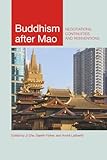Buddhism after Mao : Negotiations, Continuities, and Reinventions / ed. by André Laliberté, Gareth Fisher, Zhe Ji.
Material type: TextPublisher: Honolulu : University of Hawaii Press, [2020]Copyright date: ©2019Description: 1 online resource (364 p.) : 7 b&w illustrationsContent type:
TextPublisher: Honolulu : University of Hawaii Press, [2020]Copyright date: ©2019Description: 1 online resource (364 p.) : 7 b&w illustrationsContent type: - 9780824877347
- 9780824880248
- 290
- online - DeGruyter
- Issued also in print.
| Item type | Current library | Call number | URL | Status | Notes | Barcode | |
|---|---|---|---|---|---|---|---|
 eBook
eBook
|
Biblioteca "Angelicum" Pont. Univ. S.Tommaso d'Aquino Nuvola online | online - DeGruyter (Browse shelf(Opens below)) | Online access | Not for loan (Accesso limitato) | Accesso per gli utenti autorizzati / Access for authorized users | (dgr)9780824880248 |
Frontmatter -- CONTENTS -- ACKNOWLEDGMENTS -- Introduction: Exploring Buddhism in Post-Mao China -- Part I. Negotiating Legitimacy: Making Buddhism with the State -- 1. Buddhism under Jiang, Hu, and Xi: The Politics of Incorporation -- 2. Administering Bodhisattva Guanyin's Island: The Monasteries, Political Entities, and Power Holders of Putuoshan -- 3. Spiritual Technologies and the Politics of Buddhist Charity -- 4. Tourist Temples and Places of Practice: Charting Multiple Paths in the Revival of Monasteries -- Part II. Revival and Continuity: The Monastic Tradition and Beyond -- 5. Bridging the Gap: Chan and Tiantai Dharma Lineages from Republican to Post-Mao China -- 6. "Transmitting the Precepts in Conformity with the Dharma": Restoration, Adaptation, and Standardization of Ordination Procedures -- 7. Schooling Dharma Teachers: The Buddhist Academy System and Sangha Education -- 8. A Study of Laynuns in Minnan, 1920s-2010s: Buddhism, State Institutions, and Popular Culture -- Part III. Reinventing the Dharma: Buddhism in a Changing Society -- 9. Urban Restructuring and Temple Agency-a Case Study of the Jing'an Temple -- 10. Places of Their Own: Exploring the Dynamics of Religious Diversity in Public Buddhist Temple Space -- 11. Cyberactivities and "Civilized" Worship: Assessing Contexts and Modalities of Online Ritual Practices -- References -- About the Contributors -- Index
restricted access online access with authorization star
http://purl.org/coar/access_right/c_16ec
With well over a 100 million adherents, Buddhism emerged from near-annihilation during the Cultural Revolution to become the largest religion in China today. Despite this, Buddhism's rise has received relatively little scholarly attention. The present volume, with contributions by leading scholars in sociology, anthropology, political science, and religious studies, explores the evolution of Chinese Buddhism in the post-Mao period with a depth not seen before in a single study. Chapters critically analyze the effects of state policies on the evolution of Buddhist institutions; the challenge of rebuilding temples under the watchful eye of the state; efforts to rebuild monastic lineages and schools left broken in the aftermath of Mao's rule; and the development of new lay Buddhist spaces, both at temple sites and online.Through its multidisciplinary perspectives, the book provides both an extensive overview of the social and political conditions under which Buddhism has grown as well as discussions of the individual projects of both monastic and lay entrepreneurs who dynamically and creatively carve out spaces for Buddhist growth in contemporary Chinese society. As a wide-ranging study that illuminates many facets of China's Buddhist revival, Buddhism after Mao will be required reading for scholars of Chinese Buddhism and of Buddhism and modernity more broadly. Its detailed case studies examining the intersections among religion, state, and contemporary Chinese society will be welcomed by sociologists and anthropologists of China, political scientists focusing on the role of religion in state formation in Asian societies, and all those interested in the relationship between religion and social change.
Issued also in print.
Mode of access: Internet via World Wide Web.
In English.
Description based on online resource; title from PDF title page (publisher's Web site, viewed 02. Mrz 2022)


